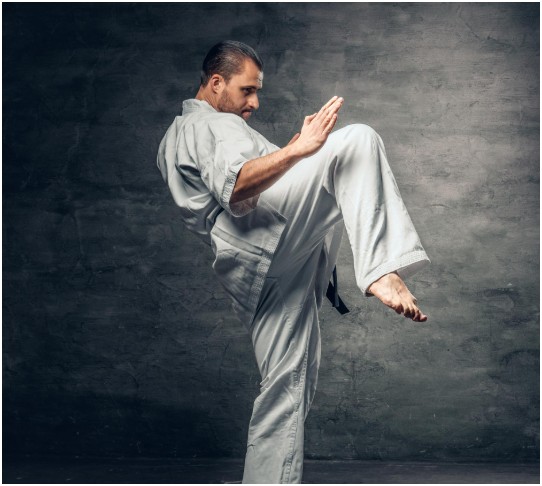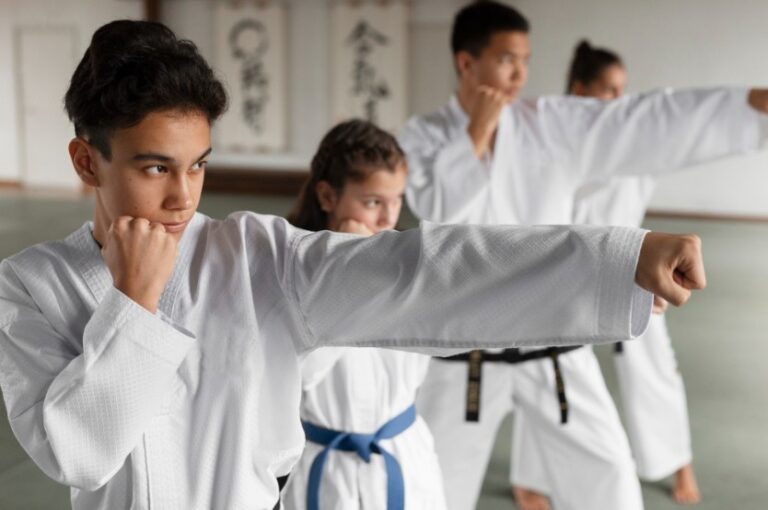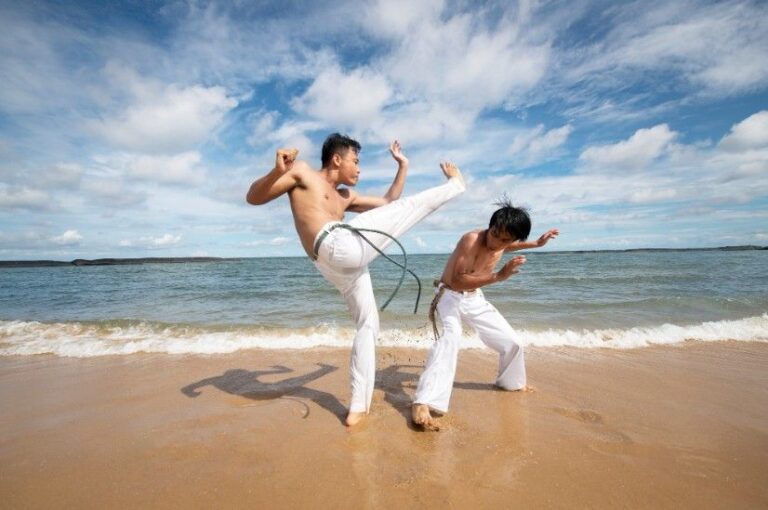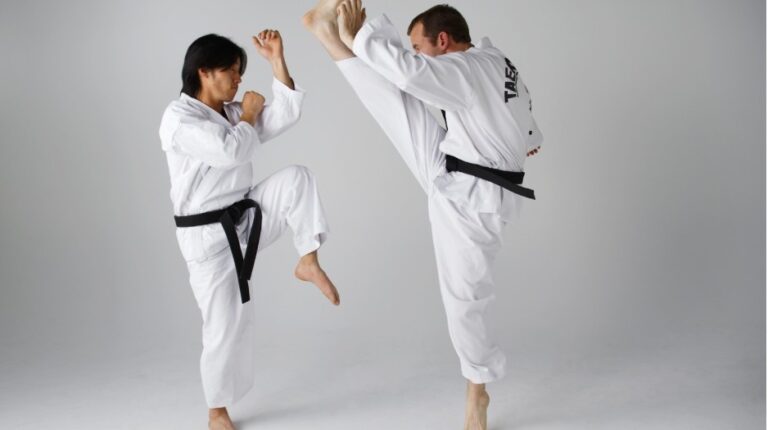So, you’re scrolling through YouTube, watching epic flying kicks and crisp white uniforms, and you start wondering: what is Taekwondo, really? Is it just about yelling “KIAI!” and breaking boards with your foot? Or is there more to it than meets the black belt?
Spoiler alert: there’s way more.
If you’ve ever been curious about this high-energy, high-discipline Korean martial art that’s taken over dojangs and Olympic podiums across the world (especially in the good ol’ USA), buckle up.
We’re about to deep-dive into everything you need to know to understand what Taekwondo is, and why it’s equal parts art, sport, philosophy, and life-changer.
First Things First: What Is Taekwondo?

Let’s break it down:
- Tae = to kick or strike with the foot
- Kwon = to punch or strike with the hand
- Do = the way or path (as in “the way of life”)
So, what is Taekwondo? It’s “the way of the foot and fist.” But more than that, it’s a discipline built on respect, perseverance, integrity, and yes, some seriously flashy moves.
Developed in post-WWII Korea and officially recognized in 1955, Taekwondo blends ancient martial traditions with modern-day sports science. Today, it’s one of the most popular martial arts globally—with over 80 million practitioners in more than 200 countries, including a ton of dojangs (training halls) in the U.S.
How Old Is Taekwondo?
Though modern Taekwondo was officially established in 1955, its roots go way deeper—2,000 years, to be exact.
It evolved from ancient Korean martial arts like Taekkyon and Hwa Rang Do, practiced by warriors during the Three Kingdoms period. Today, it’s one of the most widely practiced martial arts in the world, with over 80 million practitioners in more than 200 countries.
Where Did Taekwondo Originate – A Quick Look at History
Where did Taekwondo originate? You guessed it—South Korea.
After the end of Japanese occupation in 1945, Korean martial arts masters unified various fighting styles, and by 1955, General Choi Hong Hi introduced the name “Taekwondo.” By the 1970s, Taekwondo went global, leading to the establishment of World Taekwondo (WT) and the International Taekwon-Do Federation (ITF).
Fast forward to 2000, and Taekwondo made its grand Olympic debut at the Sydney Games.
Is Taekwondo Karate?
Let’s clear the confusion: Taekwondo is NOT Karate. Though they’re both martial arts from Asia, they differ in origin, technique, and philosophy.
- Taekwondo = Korea, emphasizes high, fast kicks and jump kicks
- Karate = Japan, emphasizes hand techniques and linear movements
Think of it this way: If Karate is about precision and strength, Taekwondo is about speed and flair.
Is Taekwondo Martial Arts?
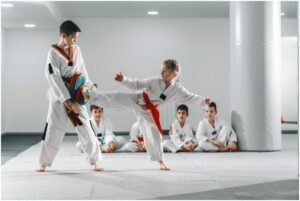
Yes, Taekwondo is martial arts—but with its own unique twist. It combines combat techniques, self-defense, sport, and philosophy into one disciplined package.
What sets it apart? Its focus is on kicking techniques, which are more prominent and advanced than in many other martial arts. Practitioners don’t just learn how to fight; they’re trained to respect, think critically, and live with integrity.
Is Taekwondo a Sport?
Absolutely. While it began as a form of self-defense, Taekwondo is now a full-blown international sport. It’s been in the Olympics since 2000 and is recognized by global bodies like:
- World Taekwondo (WT)
- USA Taekwondo (USAT)
- International Taekwon-Do Federation (ITF)
As a sport, it features sparring (Gyeorugi), forms (Poomsae), and competitive tournaments for all ages and levels.
Does Taekwondo Use Weapons?
Traditionally, Taekwondo is an unarmed martial art. However, some styles and schools introduce weapons training (especially under ITF or for demo purposes), including:
- Bo staff
- Nunchaku
- Kamas
- Sword (Mok geom)
Still, weapons aren’t central to most Taekwondo curriculums—you’ll likely spend more time perfecting your spinning hook kick than twirling a sword.
Why Americans Are Obsessed With Taekwondo
Let’s get real. Americans love anything that combines power, performance, and personal growth. And Taekwondo checks every single box:
- ✅ Cardio? Check.
- ✅ Self-defense? Absolutely.
- ✅ Olympic potential? You betcha.
- ✅ Inner peace and focus? Like, Zen-level.
Whether you’re 5 or 55, Taekwondo meets you where you are and helps you kick your way to who you want to be.
Top 10 Reasons to Fall in Love With Taekwondo

Here’s why Taekwondo isn’t just a martial art—it’s a lifestyle:
- Fitness Freak-Approved: Expect improved strength, flexibility, endurance, and balance.
- Mental Mastery: Builds focus, memory, and emotional regulation.
- Self-Defense Skills: Practical techniques for real-world safety.
- Discipline Galore: Teaches patience, respect, and consistency.
- Cultural Connection: Dive into Korean traditions and philosophy.
- Confidence Boost: From white belt to black, each level unlocks more self-assurance.
- Olympic Recognition: It’s an official Olympic sport since 2000.
- Community Vibes: Be part of a global, supportive martial arts family.
- Kids & Adults Alike: Perfect for little ninjas and grown-ups wanting to level up.
- Life Lessons for Days: From “never give up” to “stay humble,” the teachings are timeless.
Okay But Really…What Is Taekwondo Training Like?
Great question! Here’s what a typical session might involve:
- Warm-up: Dynamic stretching and light cardio
- Basics (Kibon): Fundamental blocks, strikes, kicks
- Forms (Poomsae): Choreographed movements representing attack and defense
- Sparring (Gyeorugi): Controlled combat with a partner (and gear!)
- Self-Defense: Real-life application drills
- Meditation/Breathing: Wrap it all up with focus and calm
What Is Taekwondo’s Belt System?
In Taekwondo, your belt color represents your rank—and your journey:
- White = innocence, a new beginning
- Yellow = earth, where seeds are planted
- Green = growth, like a sprouting plant
- Blue = sky, reaching for new heights
- Red = danger, increased awareness
- Black = mastery, maturity, and new beginnings (again)
Each belt is earned through exams that test your knowledge, skill, and spirit.
Global Reach: What Is Taekwondo’s Role Internationally?
Taekwondo isn’t just huge in Korea or the U.S.—it’s a worldwide phenomenon.
- Over 80 million practitioners globally
- Official Olympic sport since Sydney 2000
- Major international governing bodies like World Taekwondo (WT) and International Taekwon-Do Federation (ITF)
- Annual events include the World Taekwondo Championships, the U.S. Open, and more
Where Can I Learn Taekwondo in the USA?
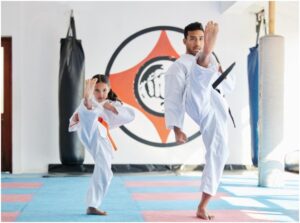
Pretty much everywhere! From bustling urban dojangs in New York and L.A. to cozy community centers in Nebraska, you’ll find instructors certified by USA Taekwondo, the governing body recognized by the U.S. Olympic Committee.
Pro Tip: Look for schools affiliated with World Taekwondo or ITF, and check for certified black belt instructors.
Fun Fact Break!
- Taekwondo is the most practiced martial art in the world.
- In South Korea, students often take it as part of their school curriculum!
- Bruce Lee studied Taekwondo alongside other martial arts—yes, even he was impressed.
Still Wondering What Is Taekwondo?
If you’ve made it this far, you’re already getting the idea. But just to recap:
- It’s a martial art.
- It’s a sport.
- It’s a lifestyle.
- It’s a journey from “What am I doing?” to “I got this.”
From White Belt to Warrior: Now You Know What Taekwondo Really Is
So, what is Taekwondo? It’s discipline dressed in a dobok. It’s empowerment wrapped in a roundhouse. It’s more than just kicks and punches—it’s a path to your best self.
Whether you want to get fit, feel safer, find focus, or compete with the best, Taekwondo is the ultimate martial arts power move.
Now the only question is—are you ready to step onto the mat and begin your journey?
👊 KIAI!





